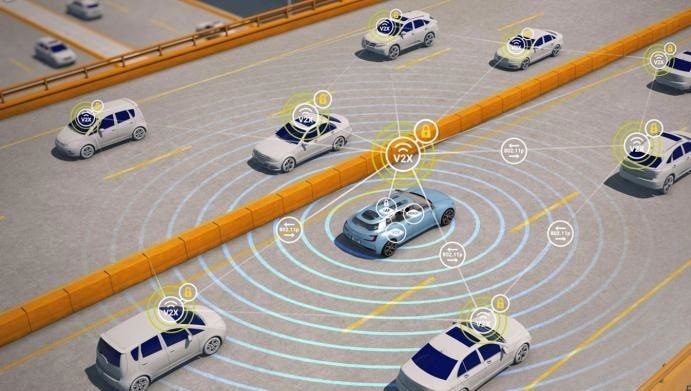The steady evolution of the automotive industry towards autonomous and connected vehicles holds highly promising prospects for the future of vehicles – better road safety, ease in traffic congestion and a reduced environmental impact. In fact, reports estimate that the number of operational connected vehicles will witness an immense surge to hundreds of millions by the year 2025.
This evolution is supported by robust technological progress in the industry, particularly the advent of a novel communications technology, cellular vehicle-to-everything (C-V2X). Cellular V2X is a key contributor to the expansion of vehicle automation by establishing lines of communication between vehicles, roadside units and even pedestrians, making the vehicle more aware of its surroundings.
While autonomous driving is already making some headway with technologies like LiDAR (Light Detection & Ranging), cameras and sensors, these systems face restrictions due to their dependence on the line-of-sight. C-V2X circumvents these issues and complements the sensors’ abilities by offering a non-line-of-sight 360°awareness. This expands the vehicle’s ‘vision’ to greater distances, including even blind turns and low-visibility weather conditions.
C-V2X market growth is propelled even further by the ongoing commercialization of cellular technologies. These include systems like LTE, which reinforce smart transportation applications such as collision warning & avoidance, lane keeping assistance and obstacle detection, among others.
Growing adoption of connected and autonomous vehicles
Many eminent automotive industry participants including the likes of BMW, Lexus and Mercedes are endorsing autonomous vehicle technologies. For instance, Tesla’s driverless Autopilot system has already been tested on roads in the UK. Meanwhile, Google is working towards advancing its automated driving technology in the wild and Apple is allegedly working with BMW to develop its own automated vehicle.
While the automated driving technology is still developing, it is making great headway in the global market. The partially autonomous vehicle market is anticipated to record a valuation of nearly $36 billion by 2025. Fully automated vehicles on the other hand, are expected to register a value of approximately $6 billion over the same period.
Industry experts believe that the key factor towards advancing autonomous driving, is better connectivity between traffic infrastructure and vehicles. C-V2X technology, therefore, is believed to be essential for the growth of autonomous driving systems in the years ahead.
With the automotive industry making persistent efforts towards developing autonomous and connected vehicles, the cellular vehicle-to-everything market is poised to witness a massive surge in demand over the coming years. This implementation of the C-V2X technology in self-driving vehicles will allow them to relay their current positions to nearby traffic and can also create alerts to prevent potential mishaps.
Since autonomous vehicles need a more precise and accurate path planning method, C-V2X systems facilitate communications between the vehicle and its surroundings, in turn mitigating the risk of collision or accidents.
One of the staunchest supporters of connected vehicle infrastructure is the German automotive sector. In fact, noted German automobile manufacturers including BMW, Audi and Daimler invested nearly $3.1 billion to procure the Nokia Here mapping service earlier this year. The service was purchased as a platform to facilitate a connected-vehicle environment.
5G and the cellular Vehicle-to-Everything (C-V2X) industry outlook
5G is considered to represent the future of mobile internet connectivity. This network, a combination of cutting-edge research and revolutionary technologies is expected to offer myriad benefits. These include faster internet speeds, more reliable connectivity in cell phones and other devices and average download speeds of nearly 1GBps, to name a few.
5G networks have already started making their presence known in the current scenario and are expected to launch globally by 2020. These networks will work alongside the existing 3G and 4G technologies and offer enhanced connectivity and high speeds even in remote locations.
The cellular V2X technology is built to be fully compatible with 5G technology, which means that the risk of infrastructure and module investments going obsolete is little to none. Once the 5G era arrives, C-V2X technology will host a plethora of advanced safety features such as precise ranging and positioning to accelerate the development of connected and automated driving, very low latency levels easing high density platooning and dynamic mapping supported by camera and sensor data.
Furthermore, the ability of 5G networks to support higher numbers of connections in small areas will allow individual vehicles to obtain more data regarding their surroundings. These developments are expected to bolster the potential of C-V2X technology in the implementation of completely autonomous vehicles, thereby transforming travel experiences across the globe.
Recently, tech innovator Qualcomm® developed a new 5G compatible C-V2X ASIC, dubbed Qualcomm 9150 C-V2X ASIC, designed to complement Advanced Driver Assistance System sensors.
Future landscape of CV2X technology and connected driving
Rapid technological innovations are contributing towards the emergence of a highly data-driven, automated and connected future of transportation. The mobility concept is undergoing numerous transitions, driven significantly by the progression of C-V2X technology.
As this technology gains traction at a breakneck speed, the day it reaches the mainstream industry is not too far ahead. In fact, studies have shown that global revenues from the cellular vehicle-to-everything market are expected to reach nearly $62.7 billion by 2023.
Prominent players in the telecom and automotive industries are exhibiting widespread acceptance of C-V2X technologies. A cross-industry group built to support 5G V2X technologies, the 5GAA, comprising leading firms like Land Rover, Nissan, Jaguar, Ford, Daimler, Volkswagen, Audi and many more, has also expressed its strong support for the technology.
The C-V2X technology is likely to demonstrate several benefits to road safety as well. For example, according to US Department of Transportation forecasts, the implementation of V2X technology is expected to save nearly 1,000 lives in just the U.S alone, in addition to reducing non-fatal injuries by nearly 2.3 million. Moreover, the technology may also mitigate global GHG emissions from transportation by nearly 14%.
Some of the key findings from the CV2X market report include:
According to Global Market Insights, the Cellular Vehicle-to-Everything (C-V2X) market size is expected to surpass USD 900 million by 2025 while exhibiting a consistent CAGR of over 10% between 2019 and 2025. The study takes into account the recent innovations by major technology players such as Huawei, Intel, Bosch, Infineon, and Qualcomm in C-V2X solutions. The companies are investing significantly in developing advanced vehicle connectivity solutions to ensure effective compatibility with upcoming technologies such as autonomous driving and 5G telecom networks.
The market growth is attributed to the growing interest among the government agencies, automakers and mobile operators to conduct extensive tests and trails of C-V2X connectivity. Some of the major companies working on the development of C-V2X connectivity solutions include Huawei, Intel, Bosch, Infineon, and Qualcomm.
The technology is also designed to be compatible with upcoming 5G networks which will further enable the mission-critical V2X communications and act as ultimate platform to enable the Cooperative Intelligent Transport Systems (C-ITS) services. Some of the rapidly emerging use cases include autonomous driving, platooning, vehicle safety and traffic efficiency.
In the global C-V2X market, North America is projected to hold a market share of over 20% due to favorable government support for the development of autonomous cars and the growing popularity of C-V2X as compared to 802.11p-based system in vehicles. In December 2018, 5GAA submitted a petition to allow for C-V2X deployment in the U.S. To improve vehicular safety and traffic efficiency, the National Highway Traffic Safety Administration (NHTSA) in January 2017 issued a Notice of Proposed Rulemaking (NPRM) to mandate the inclusion of V2V technology in all new cars. Such initiatives and regulatory frameworks are expected to accelerate the further innovation in C-V2X solutions.
Author: Saloni Walimbe, Global Market Insights (GMI)





